#websitetranslation
Explore tagged Tumblr posts
Text
How to Know If Your English to Assamese Translation Project Is Working?
So, you have finished translating from English to Assamese. Awesome! But here's the actual question: Did it work? Did it give your business, users, or team what they needed?
You can't just assume that it did. You need something tangible to go by to properly know how well your translation effort did. That's where KPIs, or key performance indicators, help you to keep track. They help you keep track of your progress, find areas that need work, and make future projects run more smoothly.
Let's talk about which KPIs are important when doing English to Assamese translation of information, whether it's for a website, an app, a document, or something else.
1. Is the Translation Accurate Enough?
Accuracy is where it all begins. If the meaning changes or if a sentence sounds weird in Assamese, users notice.
You don’t need a complex system here. Just get a few bilingual reviewers to check samples of the content. Ask: Does it feel natural? Is the message the same? Are any cultural nuances off?
If you’re getting 95% or more accuracy in these reviews, you're doing fine. Anything below that might need a second look, maybe better tools or updated glossaries.
2. How Fast Was It Done?
Speed matters more than people think. If your Assamese version of the app or announcement shows up days after the English one, that’s a problem.
Track how long it took from the time the original content was ready to when the Assamese version went live. Faster doesn’t always mean better, but a long delay can mean workflow issues, tool problems, or a bottleneck in approvals.
3. What Did It Cost per Word?
Budgets aren’t endless, so knowing your cost per word is important. Divide your total spend by the number of words translated. This gives you a basic idea of your translation efficiency.
Some content may cost more, legal documents or medical content, for example. But if your costs keep climbing without better output, it’s time to review your setup.
4. Was Editing a Nightmare?
If you’re using any AI or machine translation tools, another smart KPI is how much editing was needed after the first draft. This is often called post-editing effort.
Less editing means your tool is doing a good job. If your editors are rewriting most of the content, you might be better off switching tech or retraining your system.
5. Did Users Like It?
Here’s one that people often skip: Ask your users. Native Assamese speakers using your app, reading your blog, or watching your video will instantly know if something feels off.
A quick user poll, app review section, or even one-on-one interviews can tell you a lot. If feedback is positive, your team nailed it. If it’s mixed or negative, that’s your cue to dig deeper.
6. How Many Times Was It Sent Back?
It's not a good sign if your QA team or customer keeps sending translations back.
Keep track of how many files or tasks need to be redone. If your rejection rate is modest, ideally under 5%, you are doing well. If the rate is higher, see if the problem is with the brief, the translator, or the technology.
7. What percentage of the work was finished?
English to Assamese Translation might happen in steps at times. You could have 10 pages of English content but only 6 pages of Assamese content. That's fine during rollouts, but it's a good idea to keep watch.
Look at how much English content there is compared to how much Assamese content there is now. This helps you feel like you're making progress on the project and that you're reaching your goals.
Conclusion
Just because you finished a translation job doesn't guarantee it worked. Looking at results, quality, speed, cost, user reaction, and becoming better over time is how you really succeed.
Don't skip these KPIs if you want to reach Assamese-speaking users. They will help you understand things, point you in the right direction, and get better results all around.
1 note
·
View note
Text
#WordPress#WPML#MultilingualWebsite#WebsiteTranslation#SEO#Localization#WordPressTips#WPDevelopment#WebDesign#GlobalMarketing
0 notes
Text
Unlock Regional Potential: A Complete Guide to Website Translation
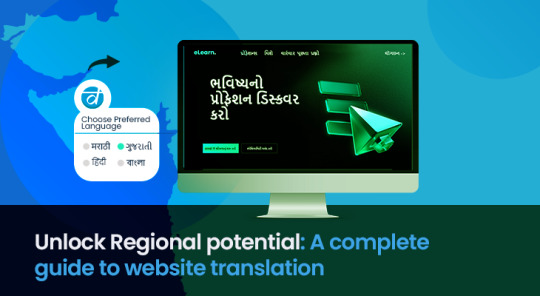
In today’s globalized world, a website is often the first point of contact between a business and its audience. However, language barriers can hinder engagement and limit reach. Website translation goes beyond mere language conversion; it adapts content to resonate with cultural nuances, local preferences, and regional expectations. By investing in website translation, businesses can expand their audience, enhance user experience, and boost SEO performance. This guide explores the critical steps, tools, and benefits of website translation, helping you effectively unlock your brand’s regional and global potential.
For More Info:
https://devnagri.com/unlock-regional-potential-a-complete-guide-to-website-translation/
#WebsiteTranslation#GlobalReach#LocalizationMatters#RegionalExpansion#ContentLocalization#TranslateYourWebsite#GlobalBusinessGrowth#LanguageLocalization#CrossCulturalCommunication#MultilingualMarketing#WebsiteLocalization#DigitalExpansion#GoGlobal#LocalizationStrategy#BusinessInternationalization#ReachNewMarkets#GrowGlobally#TranslateAndGrow#LocalizeForSuccess#ExpandRegionally
0 notes
Text
How Multilingual Websites Drive Global Growth

Having a multilingual website is no longer a luxury—it's a necessity. With businesses aiming to reach a global audience, offering content in multiple languages can dramatically expand your customer base and improve engagement. One example is catering to Tamil-speaking users through professional English to Tamil translation, which not only makes your website accessible but also shows a commitment to inclusivity.
Why Multilingual Websites Matter
Imagine visiting a website with valuable information, but it’s in a language you don’t fully understand. Would you stay and try to figure it out, or would you leave to find one that speaks your language? Many customers choose the latter, which is why multilingual websites are crucial for retaining visitors.
For businesses looking to grow internationally, the ability to communicate effectively with diverse audiences can determine whether or not you gain their trust and business. If you’re targeting Tamil-speaking regions or communities, for instance, offering your content in Tamil shows that you value their culture and are willing to invest in their user experience.
Professional English to Tamil Translation
Creating a Tamil version of your website is more than just translating words from English to Tamil. It’s about ensuring that the message, tone, and intent of your content are conveyed accurately. Professional English to Tamil translation goes beyond literal translations—it requires knowledge of cultural nuances, regional differences, and local expressions.
For example, a promotional message that works in English may not have the same impact when directly translated into Tamil. A skilled translator will adapt the language to resonate with Tamil-speaking users, ensuring that the content feels natural and engaging. This is particularly important in industries such as e-commerce, healthcare, and education, where accuracy and clarity are vital.
Reaching Tamil-Speaking Markets
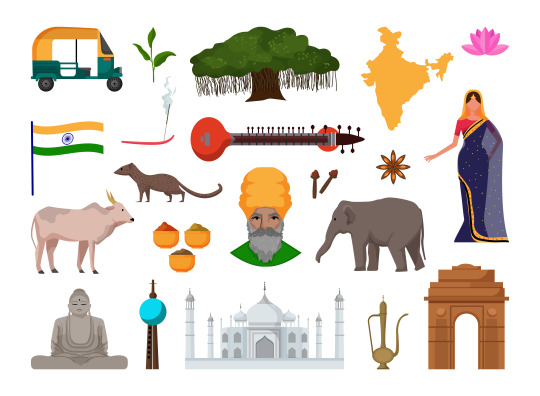
The Tamil-speaking population is significant, with over 75 million people worldwide, including large communities in India, Sri Lanka, Singapore, and Malaysia. By offering a Tamil version of your website, you can tap into this substantial market and build a stronger connection with these users.
Let’s consider an example. A global e-commerce platform looking to expand its operations in South India, where Tamil is widely spoken, would be wise to provide its website in Tamil. This not only makes the platform more accessible but also improves customer trust, leading to higher sales and user loyalty. After all, people are more likely to buy from businesses they can easily communicate with.
Enhancing User Experience and SEO
Another key benefit of multilingual websites is the improvement in user experience (UX). By offering a language option that users are comfortable with, you reduce friction and make it easier for them to navigate your site. In turn, this increases the likelihood of them staying longer, engaging with your content, and making purchases.
Multilingual websites can also boost your search engine optimisation (SEO) efforts. Search engines, such as Google, rank websites based on relevance and accessibility. By offering professionally translated content in Tamil, you can rank higher in searches conducted by Tamil-speaking users. This will drive more traffic to your site, improving visibility and market reach.
Building Trust with Tamil-Speaking Customers
Language is more than just a tool for communication—it’s a way of showing respect for your audience’s culture and identity. When you offer content in a user’s native language, they are more likely to trust your business and feel valued. This is especially true for Tamil-speaking communities, where cultural pride and language play an important role in everyday life.
Consider this: If your competitors are only offering content in English, but you’ve taken the extra step to provide a Tamil version, which business do you think Tamil-speaking users are more likely to choose? The answer is clear.
Future-Proofing Your Business
As the world becomes increasingly interconnected, businesses that embrace multilingual content will have a competitive advantage. Offering professional English to Tamil translation for your website isn’t just about meeting today’s needs—it’s about preparing for the future. Whether you’re expanding into new markets or seeking to strengthen your existing relationships with Tamil-speaking customers, having a well-translated website sets you up for long-term success.
Final Thoughts: Multilingual Websites as a Growth Strategy
In an age where every business is striving to stand out, multilingual websites offer a direct path to reaching diverse audiences and driving growth. By investing in professional English to Tamil translation, you can ensure that your business is accessible, trustworthy, and poised for success in the Tamil-speaking market.
#multilingualwebsite#globalgrowth#websitegrowth#digitalmarketing#professionaltranslation#englishtotamil#tamiltranslation#localisation#userexperience#uxdesign#seo#seostrategy#tamilmarket#culturaltranslation#inclusivity#tamilcustomers#multilingualcontent#customerengagement#websitetranslation
0 notes
Text
Unlocking Global Reach: The Power of Website Translators

In today’s interconnected world, the internet has brought people closer than ever before. However, language barriers still pose a significant challenge for businesses and individuals aiming to reach a global audience. This is where website translators come into play, transforming websites into multilingual platforms that can connect with people from different cultures and regions. Let’s dive into the importance of website translators, how they work, and why they’re essential for any website looking to expand its reach.
What Are Website Translators?
Website translators are tools or services that convert the content of a website from one language to another. They ensure that visitors who speak different languages can understand and engage with the content. Whether it’s a business website, a blog, or an e-commerce platform, website translators make it possible to cater to a diverse audience.
Why You Need a Website Translator
Expanding your website’s reach isn’t just about increasing traffic; it’s about making meaningful connections with a broader audience. Here’s why having website translators is essential:
Reach a Global Audience: With a website translator, your content can be accessed by people around the world, regardless of the language they speak. This opens up new markets and opportunities for growth.
Improve User Experience: Visitors are more likely to stay and explore your website if they can read the content in their native language. Website translators lead to higher engagement and conversion rates.
Boost SEO: Multilingual websites are more likely to rank higher in search engine results across different regions. By using website translators, you increase your site’s visibility on a global scale.
Build Trust and Credibility: Offering content in multiple languages through website translators shows that you value and respect your audience’s diverse backgrounds, which helps build trust and credibility.
How Website Translators Work
Website translators come in different forms, each offering unique features and benefits. Here’s a breakdown of how they work:
Automated Translation Tools
These are software or plugins that automatically translate your website’s content into different languages using machine translation. They are quick and easy to implement, making them a popular choice for websites with frequent content updates.
Pros:
Quick setup
Cost-effective
Supports multiple languages
Cons:
May lack accuracy
Limited ability to capture cultural nuances
Human Translation Services
For those looking for accuracy and cultural relevance, human translation services are the way to go. Professional translators ensure that the content is not only accurately translated but also resonates with the target audience.
Pros:
High accuracy
Culturally sensitive translations
Tailored to the audience
Cons:
Higher cost
Longer turnaround time
Choosing the Right Website Translator
Selecting the right website translators depends on your needs, budget, and the importance of accuracy. Here are some tips to help you make the right choice:
Understand Your Audience: Determine which languages are most important for your audience. Focus on translating your website into those languages first.
Balance Cost and Quality: While automated tools are cost-effective, they may not always be accurate. If your content requires precise translation, consider investing in human translation services.
Test Before Committing: Before fully committing, test different website translators or services on a small section of your website to see which one meets your needs.
Final Thoughts
In a world where communication is key, website translators are invaluable tools that help break down language barriers and expand your online presence. Whether you’re a small business owner, a blogger, or an e-commerce giant, translating your website can significantly impact your ability to connect with a global audience. By choosing the right website translators, you’re not just translating words—you’re building bridges to new opportunities and communities.
So, take the leap, and let your website speak the language of your audience.
0 notes
Text
The Craft and Significance of Spanish Website Translation

Overview
The internet acts as a worldwide platform for communication, business, and information exchange in our linked world. With more than 460 million Spanish speakers on the internet, translating your website into Spanish is now not merely advised, but also a critical business decision. This article explores the cultural, economic, and practical reasons why translating websites into Spanish is important for businesses and organizations who want to reach a wider audience.
Recognizing the Audience in Spanish
Spanish is an important language in the digital sphere since it is the second most spoken language by native speakers worldwide. You may reach a far wider audience by translating your website into Spanish and breaking down geographical barriers. Make sure your material speaks to the rich tapestry of linguistic variety within the Spanish-speaking population by taking into account its different cultures and subtleties.
Cultural Sensitivity and Relevance
Translation that is effective captures the spirit of the original while taking cultural quirks into account. Understanding the regional tastes, idioms, and cultural background is crucial when translating your website to Spanish. This cultural awareness builds trust, encourages a feeling of community, and increases user engagement—all of which contribute to a better overall user experience.
Financial Affect
It is obvious that translating a website into Spanish has financial advantages. Reaching out to the Spanish-speaking population can result in higher profits and faster business expansion, as they make a substantial contribution to the world economy. Providing a smooth Spanish-language buying experience may be advantageous for e-commerce platforms in particular, since it can expand their consumer base and increase brand loyalty.
Optimizing for Search Engines (SEO)
You may improve your search engine rankings by translating your website into Spanish. Websites with multilingual content are given priority by search engines because of their accessibility and inclusion. You may improve the visibility of your website in Spanish-speaking countries and attract a wider audience by optimizing your translated content for relevant keywords.
Improving the User Experience
Because there are no longer any language barriers, a Spanish-language website improves user experience. When a website is easier for visitors to navigate in their own tongue, longer browsing sessions, more engagement, and higher conversion rates result. Setting the user experience first benefits your audience as well as the general success and legitimacy of your online presence.
Handling the Technicalities
There is more to translating a website than just linguistic proficiency. Technical factors like responsive design, code, and device compatibility need to be taken into account. Working with experts in website translation provides a smooth transition and ensures that your website performs as good as possible in both Spanish and English.
Conclusion
It's not just a commercial plan, but a requirement to translate your website into Spanish in this more linked globe. In addition to the financial benefits, it promotes cultural diversity, improves user experience, and establishes your company as a major participant in the world market. The capacity to communicate effectively with a variety of audiences will become increasingly important as technology develops. Accepting website translation helps you reach a wider audience and make the internet a more accessible and inclusive place.
#WebsiteTranslation#SpanishLocalization#GlobalReach#CulturalInclusivity#DigitalExpansion#MultilingualWebsite#UserExperience#SEOBoost#LanguageDiversity#OnlinePresence#BusinessGrowth#LocalizationMatters#CrossCulturalCommunication#EconomicImpact#ResponsiveDesign
0 notes
Text
0 notes
Text
0 notes
Photo
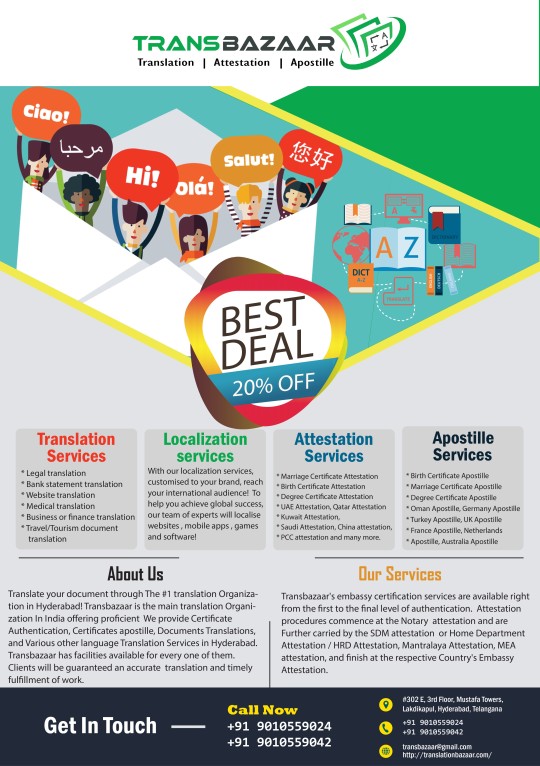
Trans Bazaar is the main translation organization in India offering proficient translation Services. Translate your documents through the #1 translation organization in Hyderabad!
Translation Services : Marriage Certificate Translation, Birth Certificate Translation, Degree Certificate Translation, UAE document Translation, Qatar document Translation, Kuwait document Translation, Saudi document Translation, China document Translation, PCC attestation, Power of Attorney document Translation, MOA document Translation
Follow our Social Media Accounts: Facebook : https://www.facebook.com/transbazaar.in Instagram : https://www.instagram.com/transbazaar/ Pinterest : https://in.pinterest.com/transbazaar/ Twitter : https://twitter.com/transbazaar_in Linkedin : https://www.linkedin.com/in/trans-bazaar-01b4611bb/ tumblr : https://www.tumblr.com/blog/translationbazaar
#translation#translationservices#interpretation#attestation#apostille#instagram#pinterest#twitter#youtube#translationagency#translationinterpreterservices#dailyquotes#quotes#freelancetranslator#languages#websitetranslation#languageskills
1 note
·
View note
Link
#content writing#website localization#contentwritingservice#beyondwordz#websites#websitetranslation#translation#medical translation services#technical translation
1 note
·
View note
Photo

You need translation almost in every industry where the platform is global. Approx 50% of the tour and travel reservations are made online and this makes a scope of hotel website translation. Hotel owners need to ensure that their website is user-friendly with respect to website language. Many of the company provides translation services of the website and ensure the right message in the right context should be delivered. Hotel websites that don’t cater to non-English speaking audiences miss out on huge revenue opportunities.
However, did you know that half of all online users are foreign, non-English speakers? According to studies, 75 percent of these non-English speaking audiences prefer to make online purchases on websites in their specific languages.
Here are five reasons why you should translate your hotel website into several languages.
Learn more: Advantages of Translating Your Hotel Website
1 note
·
View note
Text
What is Technical Translation?
Most companies have their translation services Dubai teams. But what are they doing? They’re not just asking employees to transcribe documents and answers into their native language.
It’s not always easy to know how to translate a document and speak the same language fluently simultaneously. Given that, most companies have multiple versions of English, etc., it can be difficult to know where to start. What would help is someone fluent in one or more of these languages to share their experiences with people who aren’t. This way you can learn from your mistakes (and hopefully make better translations in the future). So here are some things you need to know about technical legal translation office in dubai:
1. Technical translation is a skill
It does take a lot of time and effort to become fluent in a language. So when translating documents, you must be very careful about how you phrase things. There are many ways to say the same thing, but some are more appropriate than others. For example, “I want to go home now” can mean two very different things depending on the tone in which it is said. If it’s said in a happy tone, one could interpret it as “I am tired and want to go home now” but if it were said in an angry tone, then one could interpret it as “I want you to let me go home now!”
2. The way words are pronounced can change their meaning
This is true for any language and if you don’t know what I mean by this, just try saying the word “candy” out loud several times with different tones of voice. The same thing goes for technical translation: pronouncing words differently can change the meaning of your document entirely! This is especially important when translating medical documents because doctors have to pronounce words exactly right or they could be putting their patients at risk! So basically, when you translate technical or medical documents (or even legal documents) you have to pay attention to what each word means and how each sounds when spoken aloud. Of course, it's also how it’s pronounced.
3. Context matters
The meaning of the same word can change from one context to another. You can say, "I don't want to go home right now," as an example. It would mean something different to say it to your boss vs your spouse! Context is important when translating technical documents because the same word might not mean the same thing in different contexts or parts of the document. For example, “system” could mean a computer system, a system of government, or even a transportation system! So when translating technical documents, you must pay attention to what each word means, what kind of context it is used in, and how that changes its meaning.
4. Words can have multiple meanings depending on how they are used
This is true for every language, especially for technical translation because words tend to have more than one meaning depending on how they are used (in other words, they are polysemous). So, for example, we say “I am going up” when we are going up a flight of stairs or “I am going up” when we are going up in rank at work (or both). And since there is no way for us as native speakers to know which meaning was intended by the speaker/writer without asking them directly (and this may not always be possible but also to how it is pronounced.
5. Technical translations can be very difficult to translate
When translating a technical document, you have to be careful not to leave any details out or make any mistakes for the document to make sense. In addition, when translating a technical document that has been translated from another language into your native tongue, you have to double-check the translation because it’s possible that some of the technical terms were not translated correctly. For example, if a technical term is translated as “engine” and then someone translates that word as “car” the document's meaning will change entirely!
6. Technical translations must always be accurate
For a technical translation to be accurate, it must always follow certain rules and guidelines such as (but not limited to): using correct terminology, using correct formatting, using correct punctuation, following proper grammar and spelling rules, using proper capitalization, etc. Get in touch with Active Translation Services now.
#frenchtranslationnearme#translationinDubai#websitetranslation#documenttranslationDubai#translationserviceDubai#translatorsDubai#translationuae#legaltranslationservices#translation#translationseries#legaltranslationDubai#UAE#Dubai#AbuDhabi#websitetranslationdubai#websitetranslationindubai#localization#Activetranslationservices
0 notes
Text
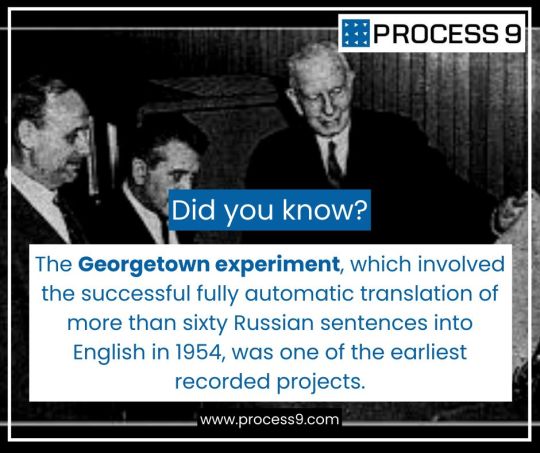
You might not know, but machine translation has been around for a long time. The Georgetown experiment was one of the earliest recorded applications in 1954, where the process successfully translated more than sixty Russian sentences into English.
#like#localization#fridayfacts#facts#fridayvibes#fridayfun#language#languageservices#languages#processnine#aboutlanguages#translationservices#websitetranslation#apptranslation#networking#inspiration#global#globalization#international#b2bmarketing#b2b#b2bsales#life#socialmedia#saas#saasmarketing#translation#product#sales#knowledge
0 notes
Text
Weglot Review: Is It The Best Translation Plugin?
Look at the detailed review of the #Weglot translation plugin and learn everything about it. Is it the best #translationplugin for automatically #translating your website content? Read the full article
1 note
·
View note
Text

Active Translation Services - Interpretation services in Abu Dhabi
Searching for Interpretation services in Abu Dhabi? We are here for you. Why you should choose us? We understand your business needs and embrace the fact that every business is unique and hence offering professional interpretation services in Abu Dhabi.
Visit us - Office 844, 8th Floor, Al Ghaith Tower, Hamdan Street, Abu Dhabi, United Arab Emirates
Call Us- +971-501289040
#Interpretationservicesinabudhabi#LegalTranslationServicesNearMe#HamdanBinMohammedStreet#frenchtranslationinabudhabi#websitetranslation#translationuae#legaltranslation#translation#translationseries#legaltranslationabudhabi#UAE#AbuDhabi#businesstranslation#Interpretationservices#localization#Activetranslationservices
0 notes
Photo
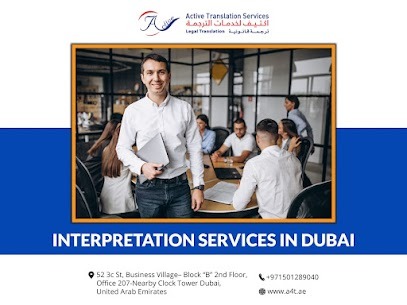
Active Translation Services- Interpretation Services in Dubai
Fast Service & Low Prices. Professional Translators. Get an Instant Quote!
☎️ +97142945585
☎️ +971501289040
#legaltranslationservicesinDubai#legaltranslationindubai#certifiedtranslatordubai#translationinDubai#websitetranslation#documenttranslationdubai#translationservicedubai#legaltranslation#translationseries#legaltranslationdubai#languagetranslationdubai#activetranslationservices#UAE#Dubai
0 notes